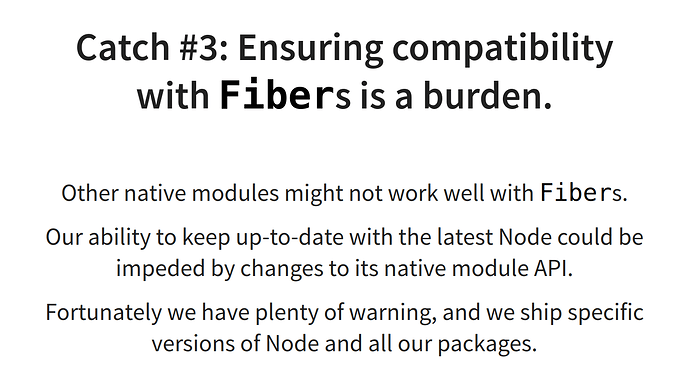Hey, as a developer I’m not a big fan of big breaking changes or full re-writes, I believe software can be written in a way that it can live for a very long time.
That said, our plan here on Meteor Software (Tiny) is to keep Meteor as compatible as possible without compromising quality, I know that is a hard task but this is what we are trying to do in every case, including Fibers.
Then our plan is to study the direct impacts of removing Fibers, we probably already know the answer but we want to confirm.
The solution I see for now is to provide a way for people to avoid Fibers but keep Fibers working for existent projects, as @alawi said unless we have a patch breaking Fibers we still have time and we can see how Fibers is going to behave on Node 16 as well before Node 14 is close to an end.
Our focus in the core now is on HMR (I’m coordinating with @zodern on this https://github.com/meteor/meteor/pull/11117), Tree-shaking (https://github.com/meteor/meteor/pull/11164) + Dead code elimination (https://github.com/meteor/meteor/pull/11107). I believe these 3 PRs are not that far from being merged. Then we can start to think about other big tasks in the core, like Fibers replacement or alternative API.
One thing I can ensure for all of you, I’m also a Meteor user, I also have Meteor apps in production (https://www.bemarke.com, https://app.archlive.com.br are just a few public examples) and then we are NOT going to do anything that is BAD for Meteor users or for companies relying on Meteor to make money. As some people mentioned in this thread, we are open to conversation, if you have any questions feel free to reach me out here on private or also on our Community Slack.
We don’t have anything to hide. Our roadmaps (Galaxy and Meteor) are public and we want the best for Meteor in all possible ways. As I said in the podcast, Tiny bought Meteor because we believe in Meteor and we are going to make Meteor better and better.
Also, a different discussion is about semantic versioning and Meteor, I believe Meteor is not bumping the version as frequent as we should, if you look to other big frameworks/platforms they are bumping the major version all the time, that is good to show for people that are not using the platform everyday that we are moving forward, that we are adding things. That (bumping the major version) is not allowed only when we add breaking changes. It’s the opposite, if you have big breaking changes you SHOULD bump your major version, if you don’t, you CAN bump your major version as well but you don’t HAVE to.
Meteor is a platform and not just a library so we can make major bumps even trying to keep our breaking changes at minimum, as we are going to do. What I mean by that is that maybe, we are going to have Meteor 2.0 soon, and then Meteor 3.0 and then 4.0 and so on. Meteor is a great platform, up-to-date with all major dependencies and we are still using Meteor 1.x for all the releases, this is not good IMO. If you are not using Meteor everyday and you see Meteor is still on 1.x as it was many years ago you are going to conclude that Meteor is dead and we know that Meteor is not dead at all.
Sorry for the long post, to wrap up:
- We are confident in the future of Meteor, keeping Fibers or providing alternatives. Meteor is not going to die because of Fibers.
- We are confident that we are one of the best choices in terms of productivity and stability for many types of web-based apps (including Hybrid Mobile apps). And we are going to be even better soon (HMR, Tree-shaking, etc)
- We are confident that Galaxy will continue to be the best way to have Meteor apps running in production. And Galaxy is also going to receive new updates (as it is already receiving many) for a long time. Cool features for the community is also in our pipeline, trust me

How you can help?
- Promote your work with Meteor for your friends and in social medias.
- Help triaging issues and reviewing PRs.
- Propose ideas and constructive threads in the Forums like this one.
- Reach us out! Don’t be afraid, we don’t bite. Are you afraid of something? Talk to us. Do you have a question? Talk to us. Our goal is to help and to improve Meteor.
See you!

 just want to make sure we are on the same page, and we are
just want to make sure we are on the same page, and we are 
